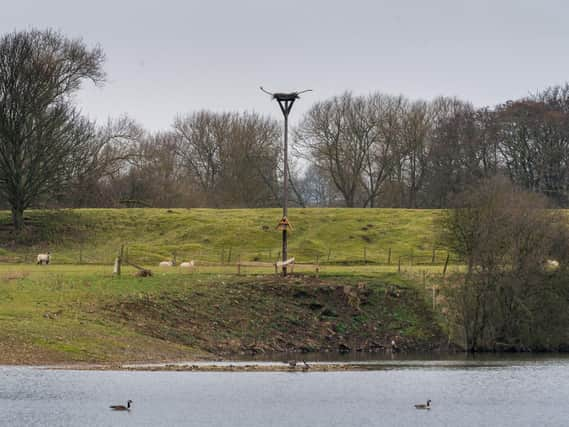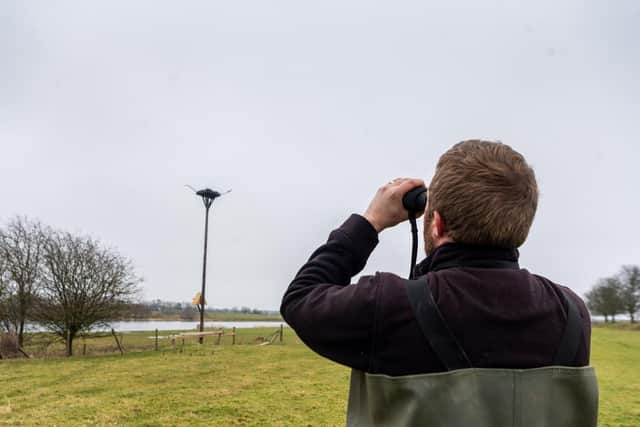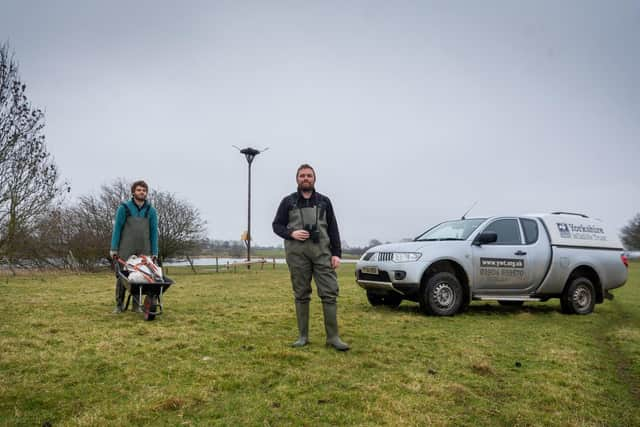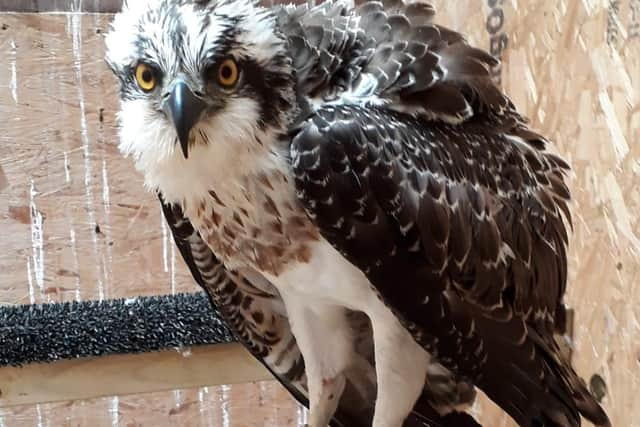How a five-year project to lure ospreys back could see them breed in Yorkshire for the first time in centuries


This magnificent bird of prey spends the winter in Africa before returning to Europe for the warmer months. Their migration routes take them to Scotland, where a breeding population has been successfully re-established, and other strongholds include Wales and the Lake District.
It is hundreds of years since they nested in Yorkshire having been persecuted because they competed with humans for resources when both species included freshwater fish as an important part of their diets. These days, ospreys are at the top of the food chain, and the increasing ecological health of rivers such as the Swale and Ure, where stocks of salmon and trout have recovered significantly, means there is now the habitat to support them as they rear their young.
Advertisement
Hide AdAdvertisement
Hide AdOspreys were declared extinct in Britain in 1916, and there were records of migratory birds being shot in Yorkshire in the 1950s - the same decade a pair nested at Loch Garten in the Scottish Highlands and the species staged a defiant comeback.


The Yorkshire Wildlife Trust has invested in their resurgence, building a giant nesting platform at Bolton on Swale Lake, a quiet, off-the-beaten-track nature reserve near Catterick that is close to the banks of the Swale and surrounded by former gravel pits now teeming with fish.
The charity also aims to replicate their efforts at newly-acquired site Ripon City Wetlands, while Natural England have erected similar artificial nesting sites in the Lower Derwent Valley and there is also an independent project to attract them to the reservoirs of the Washburn Valley, near Harrogate.
There is cause for optimism about the chances of securing a breeding pair as permanent residents, as osprey sightings have increased in recent years - they have been seen feeding in Ripon, Wensleydale and the North York Moors to prepare for their long journeys south.
Advertisement
Hide AdAdvertisement
Hide Ad"We think ospreys use landscape features like large river valleys - such as the Swale - as landmarks to navigate by and follow. Along migratory routes, they are fairly common, but they tend to return to the same nest site and the same partner each year. We want to attract young birds who need a territory of their own and want to find a mate," says the Yorkshire Wildlife Trust's Jonathan Leadley, who is overseeing the Bolton on Swale project.


"In spring, they tend to be in a hurry so sightings are brief, but in autumn, if the weather is good, they will often linger longer in one place, feeding and fattening up, so it's a much better time to see them.
"You do get individuals summering in Yorkshire - there is a site at Ellerburn Bank, near Dalby Forest, where one has spent the past two summers feeding at a nearby trout farm. They were seen in Wensleydale last June. It's happening more and more."
Bolton on Swale was chosen as a test location because there was already funding in place for habitat improvement, and Jonathan thinks that within five years ospreys will have nested there, either organically or using the artificial platform - which they hope to whitewash to give it the appearance of a well-used nest strewn with droppings.
Advertisement
Hide AdAdvertisement
Hide Ad"They need healthy water with good fish stocks. There is enough food for them now in Yorkshire as stocks have recovered. In places like Florida, they nest above motorways - they're not fussy. They will expand out of their strongholds if they have access to good fishing and there is no persecution, as they disturb easily and prefer remote places - but they're faily tolerant."


Bolton has also been selected because its visitor numbers are manageable compared to more popular nature reserves, and though there are two hides facing the platform, it is on a side of the lake that has no public access.
"We hope that our viewing point can attract tourists, because they are a spectacular species that can really engage people. We also hope to have a webcam with a live stream if we do get a nesting pair."
Jonathan is not aware of when the last Yorkshire breeding osprey was killed, and believes it may have even been before written records began.
Advertisement
Hide AdAdvertisement
Hide Ad"It's partly down to the drainage of wetlands that they declined, and they were in direct competition with humans for fish. Now we have salmon and trout farms for ourselves so ospreys are tolerated again."
In future, the platforms could also be constructed at Ripon City Wetlands, a newly-created reserve near the racecourse.
"Last autumn, two ospreys spent some time in Ripon and hung around for a while - visitors saw them fishing. It is another area which is very suitable for them."
Natural England's Craig Ralston is another conservation officer with high hopes that ospreys will soon return - and has even known an injured bird to be cared for by renowned wildlife rehabilitation expert Jean Thorpe at her sanctuary in Ryedale after it became tangled in netting at a trout farm near Driffield.
Advertisement
Hide AdAdvertisement
Hide AdHe has already become acquainted with farmers and fishing lake owners who are prepared to offset the loss of their stock by using the raptors' appeal to draw more visitors in.
At the Natural England reserve in the Lower Derwent Valley near York, around a dozen ospreys visit every spring and autumn and two nesting platforms have now been provided.
"We're on a regular migration route, and a few miles away there is a caravanning and fishing site called Pool Bridge Farm. The farmer has really embraced them and they regularly get juveniles stopping off there. He's got a platform too and a cafe, and he's been encouraging them. They had two birds last spring.
"It shouldn't be too long before they breed - it's only a matter of time. We are seeing the Scottish population increase, the recovery programme in England is doing well, and as more of the young reach maturity we should start seeing them settle between all of the sites.
Advertisement
Hide AdAdvertisement
Hide Ad"The osprey Jean Thorpe cared for in autumn 2019 was ringed in Scotland, and she released it back at the trout farm in Driffield after about two weeks. It stayed at Tophill Low nature reserve for a while."
Craig is not overly worried about conflict between ospreys and commercial fishery owners - he points out that most farms already have netting over their nursery ponds to deter herons, and that ospreys tend to target escaped fish trapped in the overflow channels and reservoirs, thus preventing them entering the river system and doing 'an environmental favour'.
"There's a big market of birdwatchers and photographers to target - at Rutland Water they run boat trips to see them now. They are iconic birds, like red kites. They also offer a great chance for farmers to diversify by openings things like cafes and gift shops."
Yorkshire's migratory osprey hotspots
Ripon City Wetlands - this new Yorkshire Wildlife Trust reserve only opened in 2019 on the site of an old quarry, but last autumn it was visited by two ospreys who delighted visitors with their fishing prowess.
Advertisement
Hide AdAdvertisement
Hide AdBolton on Swale Lake - the Yorkshire Wildlife Trust reserve near Catterick is one of the largest bodies of open water in the area, and was created from old sand and gravel pits. The location of the Trust's first nesting platform.
Washburn Valley - a series of reservoirs and lakes near Harrogate. The first migratory osprey was recorded at Lindley Wood in 1990, and since then they have been seen at other spots including Timble Ings and Fewston Reservoir. In 2018, a bird stayed at Lindley Wood for most of August. An independent project to construct nesting platforms is ongoing.
Lower Derwent Valley - the Natural England reserve near York now attracts around a dozen passing ospreys per year and two nesting platforms have now been built.
Pool Bridge Farm - this Caravan Club campsite and fishing lake complex just a short distance from Lower Derwent Valley has a nesting platform and two ospreys spent part of last summer there. The site's owner has plans to encourage more birds and attract people to watch them.
Advertisement
Hide AdAdvertisement
Hide AdEllerburn Bank - an osprey spent time at this Yorkshire Wildlife Trust wetland reserve near Dalby Forest in the North York Moors last year, feeding at the nearby Welham Park trout ponds.
Tophill Low - the osprey released by Jean Thorpe in the autumn of 2019 stayed a while at Yorkshire Water's Tophill Low reserve near Hull, which has long been thought to have good prospects of attracting ospreys fresh from crossing the North Sea.
St Aidan's and Fairburn Ings - there are yearly reports of ospreys passing through these two RSPB nature reserves to the south and east of Leeds.
Gouthwaite Reservoir - ospreys have been recorded at this Yorkshire Water site in Nidderdale.
Scaling Dam - there are regular sightings at this reservoir on the main road between Guisborough and Whitby.
Comment Guidelines
National World encourages reader discussion on our stories. User feedback, insights and back-and-forth exchanges add a rich layer of context to reporting. Please review our Community Guidelines before commenting.